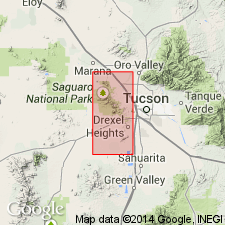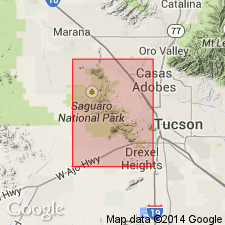
- Usage in publication:
-
- Shorts Ranch andesite
- Modifications:
-
- Original reference
- Dominant lithology:
-
- Andesite
- AAPG geologic province:
-
- Basin-and-Range province
Summary:
Pg. 734-735, fig. 2, pl. 1. Shorts Ranch andesite. One of the most massive of the series of volcanics in the area and when fresh is light purplish gray. Weathers to reddish purple or, less commonly, brown. Has marked flow structure in southern part of range. Thickness at least 400 feet and probably much thicker. West of Tucson and in area north of Ajo Road it overlies Safford tuff (new). Age is Tertiary.
Type locality: on Shorts Ranch [no longer exists], 10,000 ft northeast of Cat Mountain, Tucson Mountains, Pima Co., southeastern AZ.
Source: US geologic names lexicon (USGS Bull. 1200, p. 3589).

- Usage in publication:
-
- Shorts Ranch andesite†
- Modifications:
-
- Abandoned
Summary:
Abandoned. Replaced by informal dacite of Twin Hills. Name Shorts Ranch is abandoned because rocks are of local occurrence, consist of dacite rather than andesite, and because "Shorts Ranch" no longer exists, is not on modern topographic map, and is unknown to local people. [Author uses original spelling "Shorts Ranch andesite" of Brown (1939)]. However, Twin Hills in Tucson Mountains, Pima Co, AZ, Basin-and-Range province, is a prominent accessible locality where thick section of unit is exposed. Most exposures of dacite consist of single flow up to several hundred m thick. K-Ar biotite date of 58.3 +/-1.7 Ma by Bikerman and Damon (GSA Bull., v. 77, p. 1225-1234) should be considered minimum age because unit is weakly porphylitically altered throughout.
Source: GNU records (USGS DDS-6; Denver GNULEX).
For more information, please contact Nancy Stamm, Geologic Names Committee Secretary.
Asterisk (*) indicates published by U.S. Geological Survey authors.
"No current usage" (†) implies that a name has been abandoned or has fallen into disuse. Former usage and, if known, replacement name given in parentheses ( ).
Slash (/) indicates name conflicts with nomenclatural guidelines (CSN, 1933; ACSN, 1961, 1970; NACSN, 1983, 2005, 2021). May be explained within brackets ([ ]).

